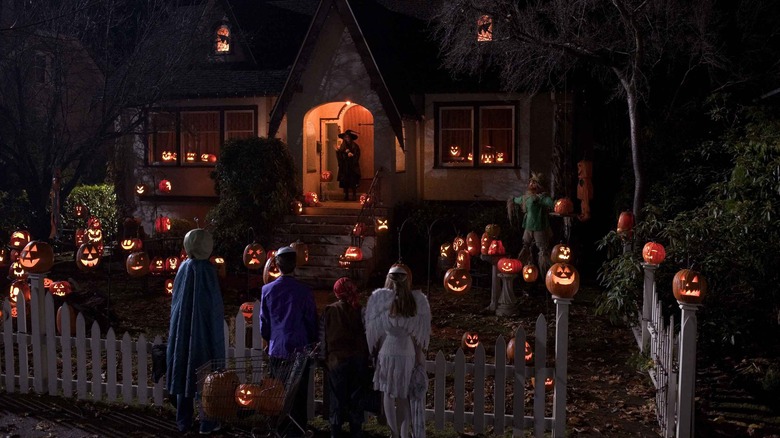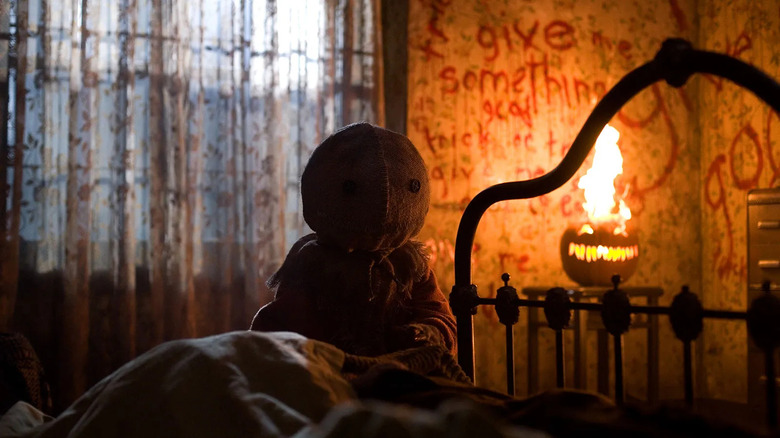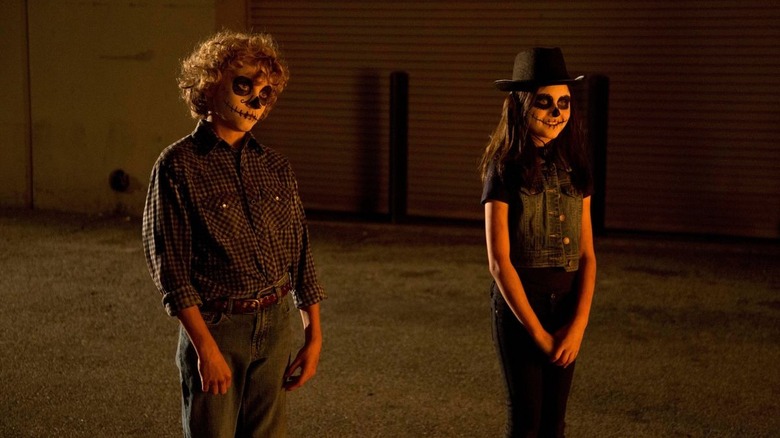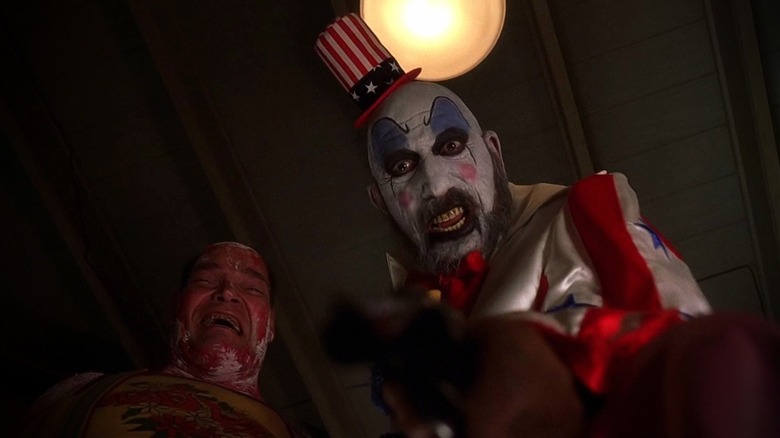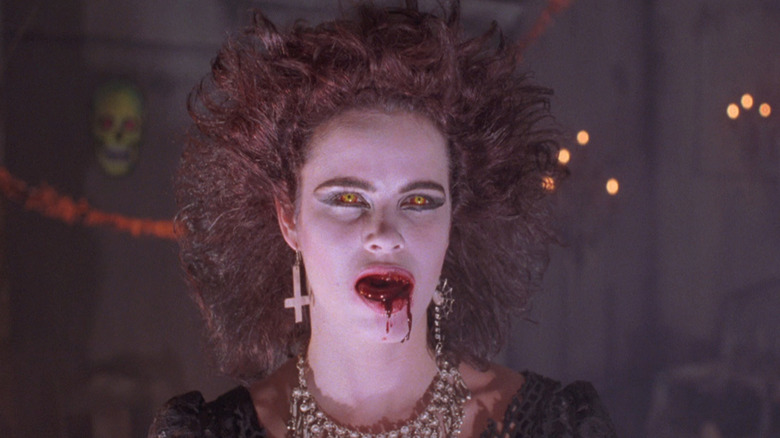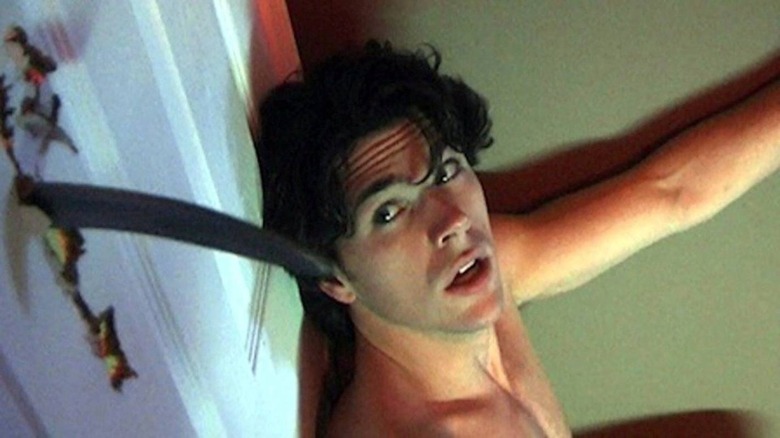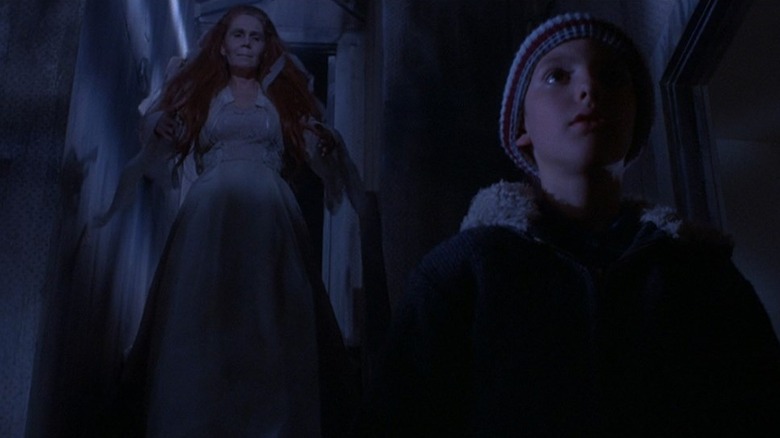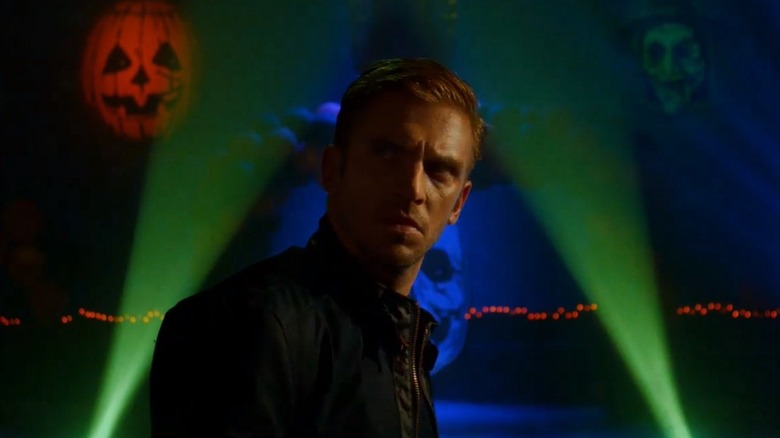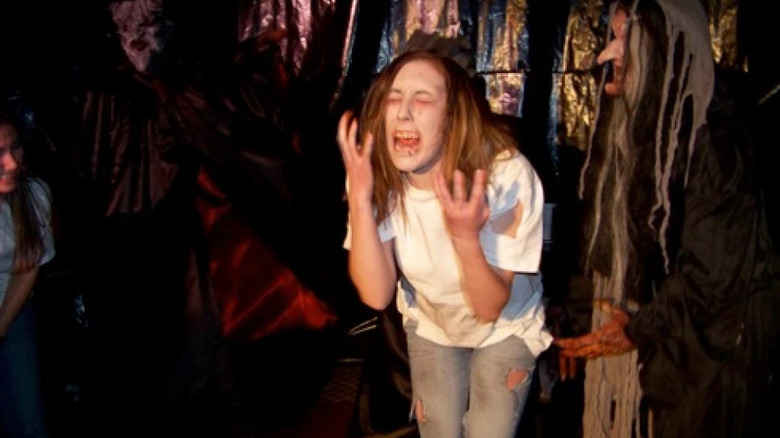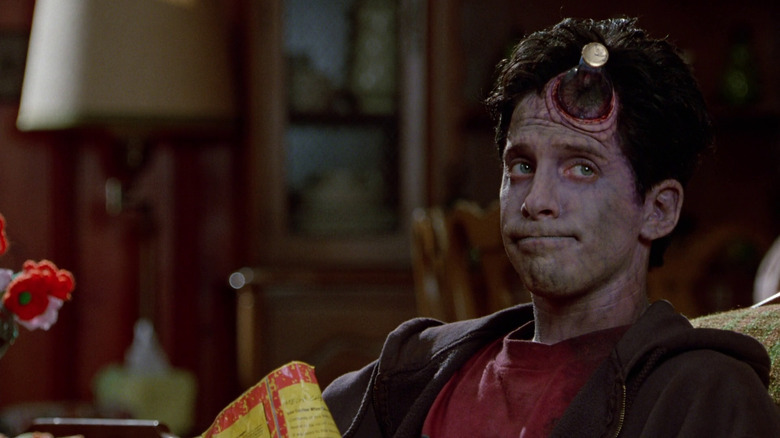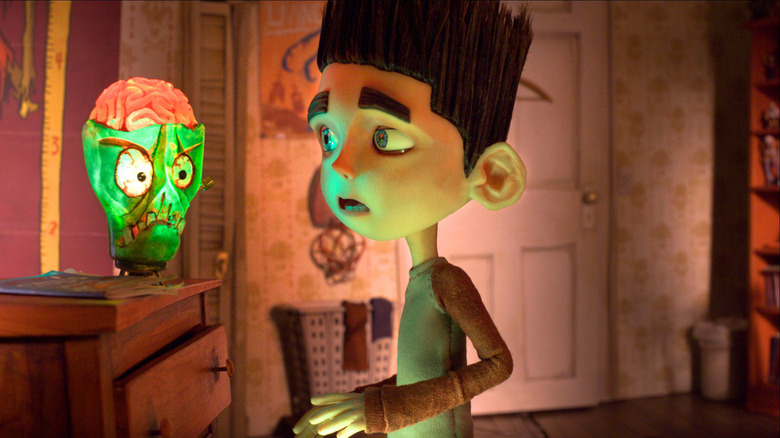12 Scary Movies That Take Place On Halloween (That Aren't Part Of The Halloween Franchise)
There was some brief debate — many years ago — as to whether or not an action picture like "Die Hard," set at a Christmas party, should qualify as a Christmas movie. That is: is "Die Hard" appropriately emblematic of the holiday season? These days, it's widely accepted as such — with some websites even finding scientific evidence to prove it — but there was a time when what did and did not qualify as a Christmas move was a matter of multiple critical kerfuffles. In 2022, the broad consensus appears to be that anything set at Christmas, even briefly, could qualify. Older critics have seen the definition broaden.
No such debate was ever required for a Halloween movie. What qualifies as a "Halloween movie" has, if one asks a die-hard horror nut, always been quite broad. Indeed, nearly anything in the horror genre can be watched in the month of October and count as a Halloween movie. The holiday is so pervasive in its spookiness that any film set during Halloween — horror or otherwise — automatically becomes a Halloween film by association.
While John Carpenter laid definitive claim to the holiday in 1978 with his film "Halloween" (soon to be 13 films old), many other horror movies can easily share the throne as notable movies of the season.
And if you seek a Halloween screening party subject but are weary of Michael Myers, any of the following twelve will do nicely.
Trick 'r Treat (2007)
In 2007, Michael Dougherty made several shorts about serial killers, werewolves, the ghosts of dead children, and a jack-o'-lantern person, and cleverly interlinked them in a fun anthology film set on October 31. As is the nature of all anthology films, certain portions are much better than others (the School Bus short is only so-so), but what Dougherty does with "Trick 'r Treat" accurately captures the mood of the season. The vibe, to use contemporary parlance.
For kids crazy about Halloween, the fall season has a definite texture, a tone that cannot quite be put into words. A mixture of nature smells, costume textures, outdoor activities, fun fear, and youthful anticipation. Dougherty understood these subtle things and compiled them into a film that feels more authentic to the season than any of the "Halloween" movies. "Trick 'r Treat" is made for the kids who understand that trick-or-treating can indeed be something of a blood sport.
In the case of Sam, the pumpkin-headed boy, it is literal.
Tales of Halloween (2015)
The subtle influence of "Trick 'r Treat" can be seen playing itself out several years later in the anthology film "Tales of Halloween," a collection of ten shorts, each made by a different director. While the moods differ from short to short — some are scary ghost stories, some are gory "Tales from the Crypt" homages, some are comedies — each one does capture something authentic about the Halloween season. Eventually, at least one filmmaker of the ten will replicate any viewer's Halloween experience.
Notables: Dave Parker's "Sweet Tooth" is a wonderful little revenge flick about the importance of letting your kid eat their Halloween candy. Ryan Schifrin's "The Ransom of Rusty Rex" is a wicked kidnapping story with a monstrous twist. Lucky McKee's "Ding Dong" is an expressionist art riff on the Hansel & Gretel story. And Mike Mendez's "Friday the 31st" is a slapstick sendup of slasher movies, asking what would happen if a Jason Voorhees type were to meet a space alien.
House of 1000 Corpses (2003)
Rob Zombie's 2003 debut feature is a filthy, sloppy mess, and audiences seemingly didn't know what to do with it. A high-octane riff on "The Texas Chain Saw Massacre," "House of 1000 Corpses" follows a group of unwitting twentysomethings as they all inexorably drift into the remote, roadside clutches of the insane Firefly family, who like to dress in costumes and torture people to death. In the catacombs under their ramshackle compound is a blood-caked cyborg called Dr. Satan. The characters are all vicious serial killers who seemingly required a self-imposed gimmick, and threw together whatever they could shoplift from the nearby Spirit Halloween Store.
"Corpses" was not well received by critics, but it served as a dark statement of purpose for Zombie who effectively declared himself a new auteur in the medium. Zombie's filmmaking acumen would only increase, and he has since made films that were equally dark and violent, but were also strangely tragic and emotionally resonant. He skews toward sadness and nihilism. The bonkers vomitorium of "Corpses" is a rough watch, but a fascinating statement of purpose.
Night of the Demons (1988) and its sequels
Kevin S. Tenney's "Night of the Demons" is Satanic late-'80s sleaze at its finest, possessed of all the blood and nudity a prurient horror fan might crave. A young Goth woman named Angela (Amelia Kinkade) has invited a group of her horny classmates to an abandoned mortuary for a Halloween party. A mishap during the party's séance unleashes a demon from the basement, and it takes turns possessing the party guests and murdering them. Couples are offed while engaging in coffin-bound coitus, and shirts fly off of torsos with shocking ease.
When old-school horror fans talk about the glories of '80s horror movies, it's likely they are referring to enjoyable shlock like "Night of the Demons." The film also features a very bizarre special effect when a young woman (Linnea Quigley), having been possessed, removes her shirt to paint her torso with lipstick. Upon completion of the activity, she inserts the whole lipstick tube directly into her nipple. Search far and wide, few other horror movies will replicate such a scene.
"Night of the Demons" was followed by two sequels and a 2009 remake.
Hellbent (2004)
Every Halloween, a block-long portion of Santa Monica Blvd. in West Hollywood, CA becomes one of the largest Halloween celebrations in all of Los Angeles. Thousands gather to show off their elaborate costumes, watch concerts, buy street food, and generally be unruly in public. In recent years, for COVID-related reasons, the WeHo Halloween carnival has been canceled, and it remains to be seen if it will ever reach the glories of its heyday.
Also, if one was unfamiliar with West Hollywood, it's also home to one of the largest, thriving queer communities in the country, and remains the home to many queer-friendly and queer-owned businesses. The WeHo Halloween carnival could, in many ways, be seen as the horror-adjacent cousin to June's Pride parades.
In 2004, director Paul Etheredge-Ouzts struck upon the rather brilliant idea to set a slasher movie on Halloween during the WeHo carnival. A devil-mask-wearing killer is stalking a central group of characters, following them into basement rooms and offing them one by one. Many don't notice because of all the costumes and mayhem. "Hellbent" isn't revolutionary in terms of its scares or its filmmaking — indeed, it looks pretty damn cheap — but it goes a long way on the novelty of its premise.
Lady in White (1988)
There isn't a name for the very particular wave of kid-centric, ostensibly appropriate kid horror flicks from the 1980s — a sub-subgenre that included "The Watcher in the Woods," "Something Wicked This Way Comes," "Poltergeist," "Paperhouse," and "The Reflecting Skin" — but Frank LaLoggia's "Lady in White" certainly falls into that camp. All of these films centered on young people, and were presumably for a young audience — they are all possessed of an Amblin-esque tone — but all of them were far too haunted and creepy to leave little kids uninflected with vicious nightmares.
"Lady in White" begins at a Halloween party in 1962, and follows a young boy (Lukas Haas) into a school cloakroom where he sees visions of a young girl who might have been murdered there in the past. This leads to a mystery as to the identity of a killer who may still be at large, as well as a secondary ghostly mystery as to the identity of the titular Lady in White.
While "Lady in White" initially bombed at the box office, it appears to be well-liked by the kids who were brave enough to have seen it in 1988. Its ghostly tone and spooky images are the stuff of classic slumber party stories.
The Guest (2014)
Partly a Halloween movie and partly a dark sci-fi tale, Adam Wingard's "The Guest" is the best Captain America movie. In "The Guest," a handsome and mysterious soldier calling himself David (the impossibly handsome Dan Stevens) arrives at the home of a fallen comrade to offer condolences, only to be offered a place to stay. David has a mercenary attitude toward life and quickly begins to take care of the host family's problems via the most violent means imaginable. Only the family's teen daughter (Maika Monroe) seems to feel something is amiss right away. Partway through the movie, it will be revealed that David was the result of a Captain America-like steroid program.
"The Guest" is wild, violent, wickedly fun, and easily one of the best films of its year. The film's Halloween connection is exploited to its fullest during its climax when David is stalking Monroe and her brother through a school Halloween ball. Attentive viewers will note that the masks on the walls of the high school gym are in fact the Silver Shamrock masks from Tommy Lee Wallace's "Halloween III: Season of the Witch," one of the crazier sequels in any franchise.
Hell House (2001)
George Ratliff's fascinating 2001 documentary film is about the very curious phenomenon of the Evangelical Christian Hell House. In Cedar Hill, TX, the Cedar Hill Trinity Church makes a great deal of money every Halloween season by building what might be described as a gigantic, multi-roomed, walking theatrical experience. Guests enter on one end, and stop at individual dioramas within the haunted house and watch teens enact scripted scenarios depicting the horrors of individual sins. Every scene features a teen on the cusp of temptation, encouraged by mask-wearing demons who take pleasure in their torment, and the teens are always divinely punished for their crimes.
It's like a live enactment of hang-writing, ultraconservative 1930s scare films — a staging of a Jack T. Chick comic — only a lot more bloody. Some of the sins in question — as dictated by the ultraconservative church putting them on — involve drinking and driving, but also school shootings, sexual assault, having an abortion, and catching HIV. Premarital sex and homosexuality seem to be the most grievous sins on the books. At the end of the Hell House, guests see all their victims in the dioramas indeed burning in Hell. The final room is a small chapel where guests can pray.
The Cedar Hill version of Christianity — a gospel of Hell and persecution — will be like a peek into an alternate universe for those on the outside. And, in its way, it's far more chilling than any fictional horror movie.
Idle Hands (1999)
No matter how bad Millennials took it on the chin from Boomers, know that Gen-X bore the exact same vitriol first. But, instead of being addicted to our phones and spending too much money on avocado toast, Gen-X was described as being dumb, lazy, stoners. For many, Beavis and Butt-Head were seen as biographical figures. The idea of the "lazy Gen-Xer" is writ large in Rodman Flender's scary and funny "Idle Hands," a film about a stoner so possessed by sloth, the Devil is permitted to occupy his own hand. Idle hands, as the saying goes, are the Devil's plaything. Anton (Devon Sawa) does little besides smoke weed and hang out with his buddies. He spontaneously loses control of his hand, and he begins unwittingly killing his buddies; Seth Green and Elden Henson, though dead, hand around to eat his chips and smoke his weed from beyond the grave.
"Idle Hands" is quite amusing, and Sawa's terror at his own behavior is perhaps the film's central appeal. Also, for the Gen-Xers in the audience, there is a cameo from the band The Offspring, playing themselves. Lead singer Dexter Holland meets a pretty grisly fate.
The kids horror movies of 2012
2012 was a wonderful year to be a kid obsessed with Halloween. In August, Sam Fell's and Chris Butler's Halloween-set stop-motion animated film "ParaNorman" hit theaters. That film, about a curious, zombie-obsessed boy named Norman (Kodi Smit-McPhee) is a wonderful movie for strange children. A savvy audience member will be able to tell the difference between a movie that is made by normal people trying to sound weird, and a movie that is made by a genuinely weird person. "ParaNorman" is decidedly the second, and Halloween-loving kids the world over were given a glorious gift that August. The character design is glorious, and the animation was revolutionary: the expedite the stop-motion process, studio Laika employed 3-D printers — a novelty at the time — to make a wider variety of models than could be made by hand in the same amount of time.
A month later, on September 28, Genndy Tartakovsky's "Hotel Transylvania" came out. That film was a "Mad Monster Party?"-inflected Monster Mash of the highest order, with funny versions of the classic Universal creature retinue, their jokes sped up to a breathtaking pace. While the film technically takes place on June 27th (established as the vampire Mavis' 118th birthday), it can be carried into the Halloween season by monster association. Plus, there's a human-thrown Monster Festival at the end. That's Halloween enough.
Then, on October 5, Tim Burton's "Frankenweenie" was released. Set in a repressed 1950s-syle town, "Frankenweenie" — about a boy who scientifically resurrects his dead dog — climaxes during an anniversary of New Holland, which — if one has an expansive enough head-canon — was the township's replacement for Halloween after the holiday had been banned for being too demonic. Sure. It counts.
